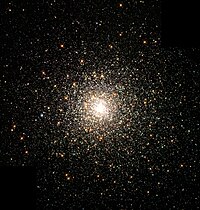
Photo from wikipedia
The heating of the intergalactic medium in the early, metal-poor Universe may have been partly due to radiation from high-mass X-ray binaries (HMXBs). Previous investigations on the effect of metallicity… Click to show full abstract
The heating of the intergalactic medium in the early, metal-poor Universe may have been partly due to radiation from high-mass X-ray binaries (HMXBs). Previous investigations on the effect of metallicity have used galaxies of different types. To isolate the effects of metallicity on the production of HMXBs, we study a sample consisting only of 46 blue compact dwarf galaxies covering metallicity in the range 12+log(O/H) of 7.15–8.66. To test the hypothesis of metallicity dependence in the X-ray luminosity function (XLF), we fix the XLF form to that found for near-solar metallicity galaxies and use a Bayesian method to constrain the XLF normalization as a function of star formation rate for three different metallicity ranges in our sample. We find an increase by a factor of 4.45 ± 2.04 in the XLF normalization between the metallicity ranges 7.1–7.7 and 8.2–8.66 at a statistical significance of 99.79 per cent. Our results suggest that HMXB production is enhanced at low metallicity, and consequently that HMXBs may have contributed significantly to the reheating of the early Universe.
Journal Title: Monthly Notices of the Royal Astronomical Society
Year Published: 2019
Link to full text (if available)
Share on Social Media: Sign Up to like & get
recommendations!